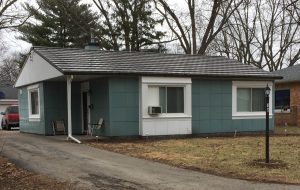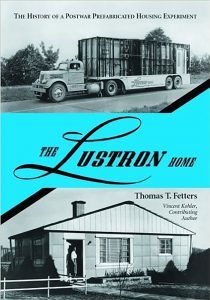All-metal homes phases was short-lived but structures survive in suburbs
Cathy Janek, for Chronicle Media — January 31, 2017

7 of 10 Lustron homes built in Aurora still stand today, including four within a two block stretch of Rosedale Avenue on the city’s far West Side. (Photo by Jack McCarthy / Chronicle Media)
A Lustron home is easy to spot.
Made out of large steel tiles and coated in enameled porcelain, these unique one-story homes are painted in hues of dove gray, desert tan, surf blue, maize yellow, canary pink or green.
Built between 1948-50 during the post-World War II housing boom, Lustron homes were marketed as affordable and maintenance-free, and some of the ranch-style structures can still be found in the western Chicago suburbs and also in 35 other states.
Despite low cost and the potential for mass production, a large-scale Lustron boom never materialized as the company struggled financially and ultimately declared bankruptcy even with a reported 8,000 contracts for homes pending.

Tom Fetters, a board member of the Lombard Historical Society, authored “The Lustron Home: The History of a Postwar Prefabricated Housing Experiment.”
Only 2,553 how the homes were ever built, according to Tom Fetters, a board member of the Lombard Historical Society and author of The Lustron Home: The History of a Postwar Prefabricated Housing Experiment.
West suburban Lombard boasts 36 surviving Lustrons — one has earned local landmark status — while others can be found in Aurora, Arlington Heights, Brookfield, Lincolnshire, Palatine and Roselle still have Lustron homes. “Rockford has 25,” Fetters said.
With the exception of a model, no Lustron homes were built in the City of Chicago. After the Great Fire, all Chicago homes built had to have plaster walls and plaster ceilings Fetters said.Since the Lustron home was built with steel not was not to code.
Built at the company’s factory in Columbus, Ohio, the homes were transported on trailers to home sites—mostly in the Midwestern and Eastern parts of the United States.
Some can even be found as far away as Venezuela. Fetters has first hand knowledge of that while traveling there on business.
Fetters also has become the “go-to” guy for information about Lustron homes and has cataloged each home detailing each home’s model number, number of bedrooms, color, and serial number.
When he moved to Lombard years ago, Fetters’ daughter would count the number of Lustron homes she saw as they drove through town.
“It was easy to keep her entertained that way,” he said. Later, his daughter did a high school science fair project about Lustron homes and during that process Fetters himself got hooked.
Illinois’ first Lustron home was erected in Hinsdale to attract potential home buyers. The last Lustron home — a two bedroom gray home — was built in McHenry.
The end came by 1953 the U.S. government foreclosed on loans and Lustron declared bankruptcy. The Columbus, Ohio plant then converted to produce defense equipment for the Korean Conflict and inventor and promoter Carl Strandlund’s dream of mass-produced homes was dead.
While some of the homes have succumbed to tear downs, others have had little modifications made to them. Some homeowners have taken out the steel interior and replaced it with drywall, Fetters said.
With a distinctive interior that included built-in kitchen cabinets, bookshelves, a china closet, and a bedroom vanity completely made of steel, these homes were a departure from the traditional homes of the time that were constructed with wood and brick.
Advertised as willing to stand up to time, the remaining Lustron homes certainly have lived up to its hype.
Fetters said, tornados have torn through towns and the only remaining homes standing have been Lustrons.
Local historical groups and other Lustron enthusiasts gather on social media to trade information about maintenance issues and post information about Lustron homes for sale around the country.
One member of the Lustron Homes History & Preservation Forum posted “When the Zombie Apocalypse happens! Your gonna want to own a Lustron.”
Ten Lustron homes were built in Aurora and seven are still standing today, according to Shanita Anderson, a former member of the Friends of Aurora Preservation Commission. Four of the homes are on a two-block stretch of Rosedale Ave. on the city’s far West Side.
Efforts have been made to protect the existing Lustron homes in Aurora with historic landmark status—unsuccessfully so far.
“I think it important that these homes are protected,” she said.







